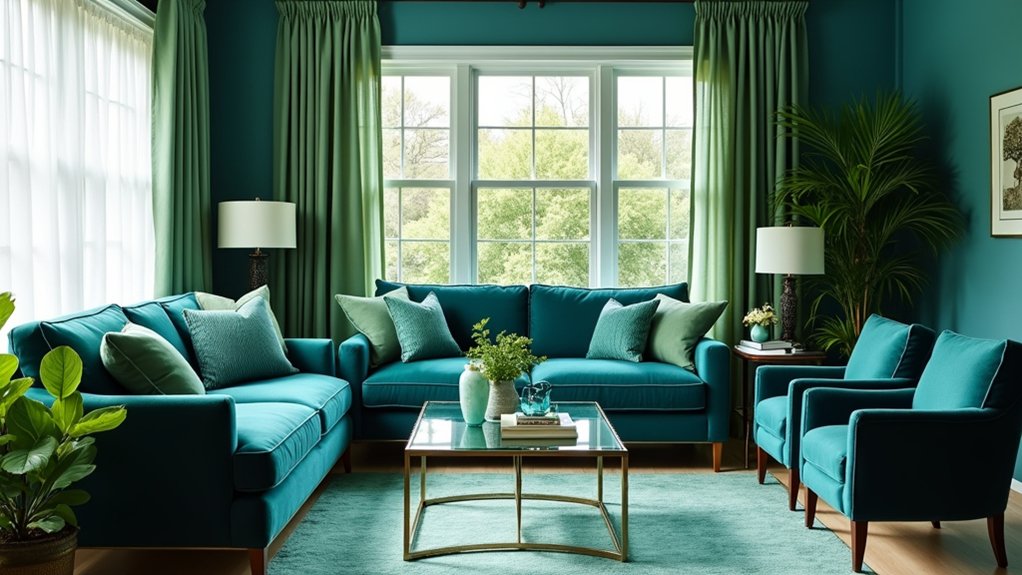
16 Green and Blue Living Room Ideas for a Bold, Balanced Look
Blue and green living rooms achieve bold, balanced impact by layering rich hues like emerald and navy with tactile elements such as velvet sofas and patterned textiles. Smoky green walls paired with blue accents enhance spatial depth, while metallic touches and botanical prints introduce visual complexity. Pastel variations create serene spring-like atmospheres, and indoor plants add organic vibrancy. Whether through color blocking, statement wallpapers, or Scandi-inspired minimalism, every choice shapes a sophisticated and cohesive design. Discover nuanced ways to combine these ideas next.
Key Takeaways
- Pair smoky green walls with velvet blue cushions and metallic accents for a sophisticated, layered look.
- Use deep navy and emerald jewel tones with contrasting textures like velvet or silk for dramatic elegance.
- Incorporate pastel blue and green for a fresh, tranquil ambience, enhanced by white or natural wood accents.
- Anchor the room with a statement velvet sofa in emerald or navy, complemented by gold or brass finishes.
- Add bold patterned rugs, cushions, and a mix of indoor plants to unify the blue-green palette and add visual interest.
Blue and Green: The Perfect Pairing
When thoughtfully combined, blue and green form a visually compelling palette that balances tranquility with vibrancy in living room design. Expert use of blue and green introduces both the calming qualities of fluid blue hues and the revitalizing energy of shades of green, resulting in a harmonious environment. Deep navy juxtaposed with emerald or forest shades of green generates a moody, sophisticated ambience, ideal for dramatic interiors. Conversely, lighter tones such as pastel blue and mint green foster a serene, uplifting atmosphere. Adding houseplants to the mix, like low-maintenance varieties such as succulents and snake plants, enhances the natural vibrancy of the room while balancing the blue and green hues. To further enhance this pairing, neutral accents—think beige textiles or light wood furnishings—anchor the space and guarantee cohesion. Incorporating patterns that blend blue and green, such as botanical or painterly motifs, adds visual depth while maintaining a balanced, expertly curated aesthetic.
Smoky Green Walls With Blue Accents
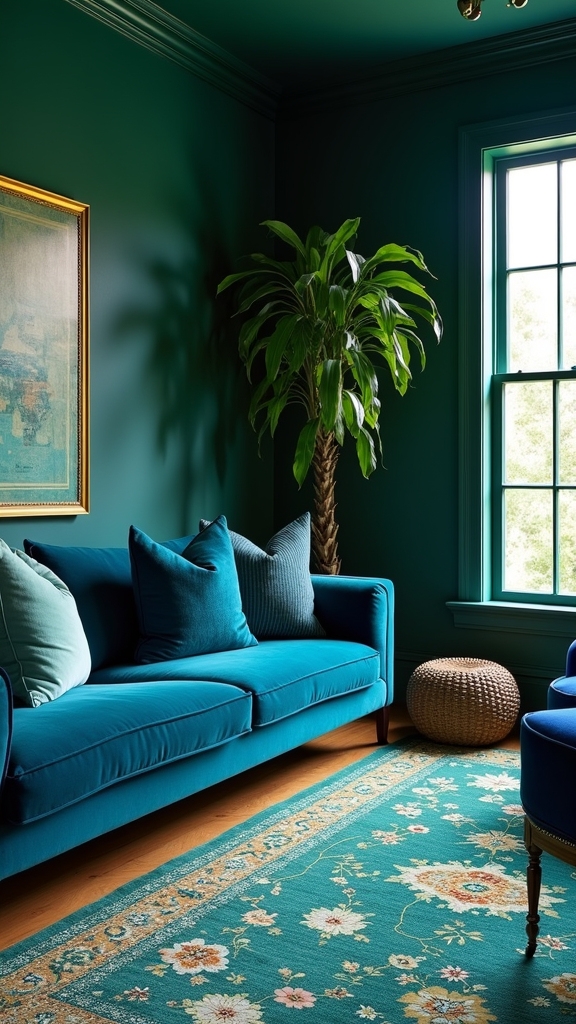
Layering tactile elements—such as velvet blue cushions against matte smoky green walls—introduces visual complexity and depth to the living room. Strategically selected metallic accents, like brushed brass fixtures or gold-trimmed mirrors, punctuate the palette with subtle opulence. Testing multiple samples on walls ensures the chosen green shade complements the decor and natural light. Balancing these rich hues and textures with restrained, neutral furnishings guarantees a harmonious and sophisticated aesthetic.
Layering Textures and Shades
A considered interplay of smoky green walls and blue accents establishes a sophisticated, inviting atmosphere in the living room.
Expertly layering textures is key to achieving visual depth and tactile richness. Green walls act as a warm, neutral foundation, enabling a spectrum of blue shades—from navy to pastel—to add vivid contrast without overwhelming the space.
Strategic use of materials amplifies this effect:
- Velvet blue pillows: Introduce plush softness against the smooth, matte finish of green walls.
- Patterned blue textiles: Incorporate throws or rugs for dynamic movement and visual intrigue atop the tranquil green backdrop.
- Layered blue drapery: Employ gradients or varying patterns to create a sense of depth and dimensionality.
This approach guarantees the living room feels balanced, visually engaging, and invitingly textured.
Enhancing With Metallic Touches
Building upon the interplay of textures and hues, metallic accents introduce a refined layer of luminosity to smoky green walls with blue highlights.
This sophisticated approach relies on the strategic placement of metallic touches—such as gold or brass fixtures—that amplify the richness of the green backdrop while accentuating blue accents throughout the space.
Blue furniture, including sofas or armchairs, juxtaposed with metallic lamps, picture frames, or side tables, cultivates a dynamic equilibrium between cool and warm undertones.
Accessories like metallic throw pillows and vases in harmonizing shades further unify the decor, reinforcing the cohesive visual narrative.
The result is a living room that feels both inviting and elegant, where each metallic touch enhances the blue accents and smoky green foundation with polished sophistication.
Velvet Sofas in Rich Jewel Tones
Velvet sofas rendered in rich jewel tones—such as emerald green and sapphire blue—instantly command attention, serving as both a luxurious anchor and a striking focal point within the living room. The sumptuous texture of velvet intensifies color saturation, elevating not only visual allure but also tactile comfort. An emerald velvet sofa, for example, juxtaposed against neutral or softly toned walls, provides a sophisticated backdrop that accentuates its vibrancy without overwhelming the space. Sage green decor‘s versatility allows it to complement serene ambiance and enhance vibrant combinations, making it an adaptable choice in various interior design styles. For visual and stylistic impact, consider:
- Pairing jewel-toned sofas with gold or brass accents to amplify opulence.
- Layering with textured cushions and throws for depth and warmth.
- Positioning the velvet sofa centrally to encourage conversation and highlight its sculptural silhouette.
Such strategic placement and accessory selection guarantee a balanced, inviting atmosphere.
Pastel Blue and Green for a Fresh Feel
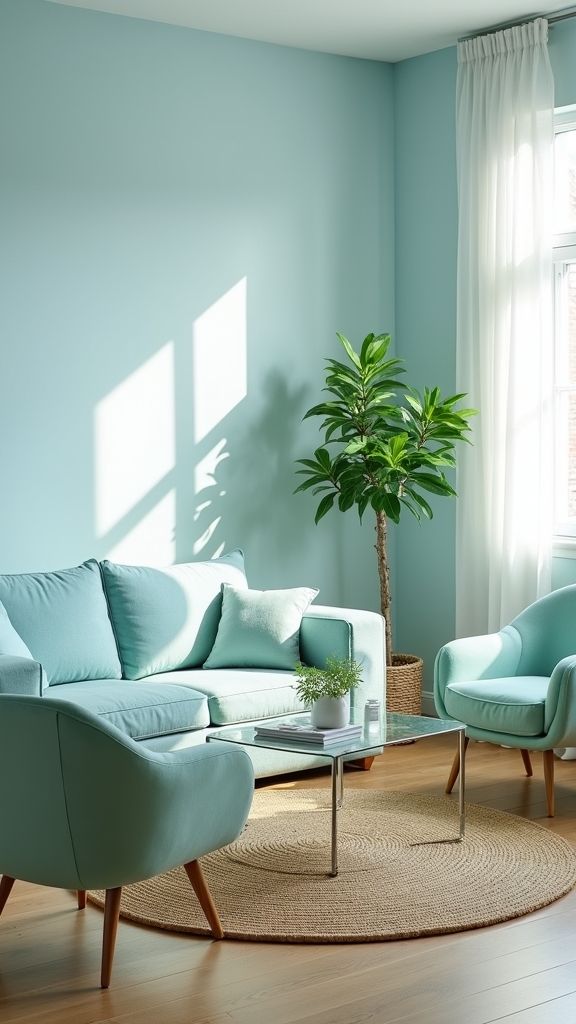
Infusing a living room with pastel blue and green establishes a fresh, spring-like ambiance that instantly enlivens the space while promoting tranquility.
The gentle interplay of pastel blue walls with green furniture introduces a sense of renewal and understated sophistication. White or neutral accents, such as light-toned rugs or minimalist shelving, amplify the airiness, maximizing natural light and enhancing the visual spaciousness.
Lightweight fabrics—think sheer curtains and linen upholstery—reinforce the uplifting mood, while subtle wallpaper in muted hues complements the pastel palette without overwhelming the room.
Incorporating natural elements such as wood and stone further grounds the design, enhancing the green theme and connecting the space to the outdoors.
This color combination is highly versatile, seamlessly integrating into both modern and traditional interiors. The result is an environment that feels energizing yet serene, making pastel blue and green an exemplary choice for balanced, inviting living rooms.
Botanical Prints and Leafy Patterns
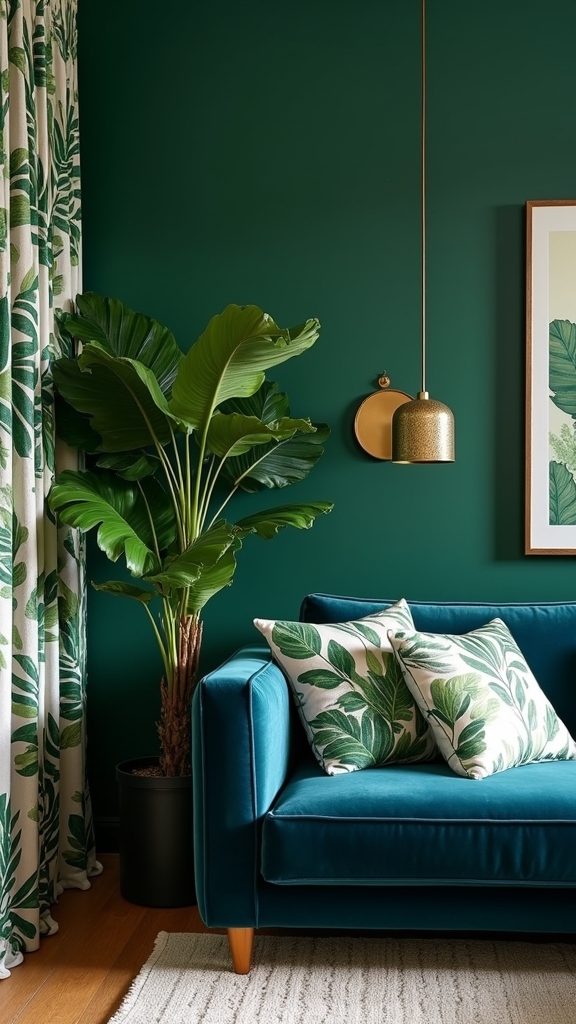
While pastel blue and green establish a serene foundation, introducing botanical prints and leafy patterns enhances the living room’s visual intrigue through organic motifs.
These elements evoke tranquility and foster a connection with nature, central to contemporary green living room ideas. Incorporating botanical wallpaper or textiles with varying scales and styles—from intricate fern silhouettes to bold, graphic monstera leaves—enables tailored visual impact.
Botanical motifs and varied textiles bring tranquility and a natural connection, key to creating a serene, contemporary green living room.
- Feature Botanical Wallpaper: Opt for oversized botanical motifs on a statement wall to serve as a dynamic focal point without overwhelming the space.
- Layer with Solid Furnishings: Anchor leafy patterns using solid blue or green upholstery for a balanced, cohesive palette.
- Integrate Real Foliage: Amplify the natural ambiance by pairing printed elements with live plants, enhancing liveliness and air quality.
This approach unifies biophilic design with sophisticated visual storytelling. Consider adding plants like Begonia Maculata to introduce striking leaf patterns that complement the room’s decor.
Dramatic Navy and Emerald Colour Drench
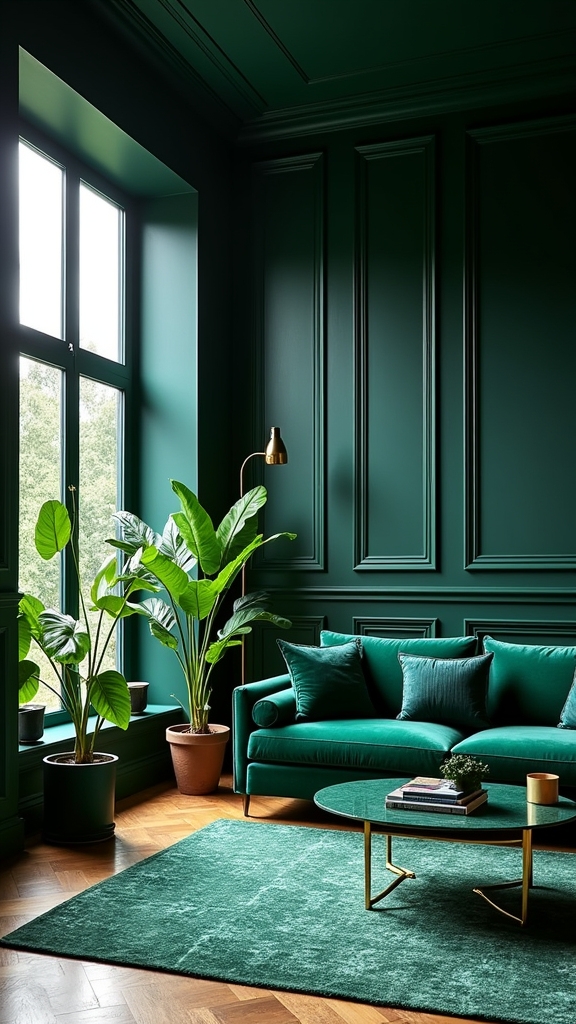
A dramatic navy and emerald colour drench commands attention through the strategic layering of deep jewel tones across walls, upholstery, and accessories.
Metallic finishes, such as gold or brass, serve as luminous accents that punctuate the saturated palette and amplify the sense of luxury.
For a well-balanced composition, designers recommend integrating varied textures and subtle neutral elements to temper the boldness and guarantee visual harmony.
Layering Deep Jewel Tones
When executed with intention, layering deep jewel tones such as dramatic navy and emerald establishes an immersive, sophisticated environment that commands visual attention.
The interplay between a saturated navy backdrop and an emerald sofa creates a rich visual tapestry, enhancing both depth and intrigue. To achieve a cohesive yet dynamic result, designers recommend the following:
- Contrast Textures: Integrate velvet or silk upholstery in deep jewel tones for a tactile, sumptuous quality that accentuates the room’s elegance.
- Vary Shades: Employ multiple shades of navy and emerald throughout the space—on walls, furnishings, and drapery—to cultivate balance and highlight architectural features.
- Focal Furnishings: Anchor the room with a statement piece, such as an emerald sofa, ensuring visual cohesion without overwhelming the overall palette.
These techniques uplift and unify bold color choices.
Accentuating With Metallic Finishes
Expertly applied, metallic finishes offer a refined counterpoint to the saturated drama of navy and emerald colour drenching in the living room.
Green and blue palettes, when enveloping walls and upholstery in deep emerald and navy, set a luxurious tone; however, the introduction of gold or brass metallic finishes enhances the scheme with a touch of glamour.
Strategically placed metallics—such as sculptural light fixtures, sleek picture frames, or curated decorative objects—provide luminous contrast that enlivens the rich, matte surfaces.
This interplay not only maximizes visual depth but also harnesses the reflective properties of metallics to disperse light, ensuring the space retains an inviting ambiance.
The result is a dynamic, balanced composition where bold colour and radiant accents coexist in sophisticated harmony.
Mixing Wood Tones With Blue-Green Palettes
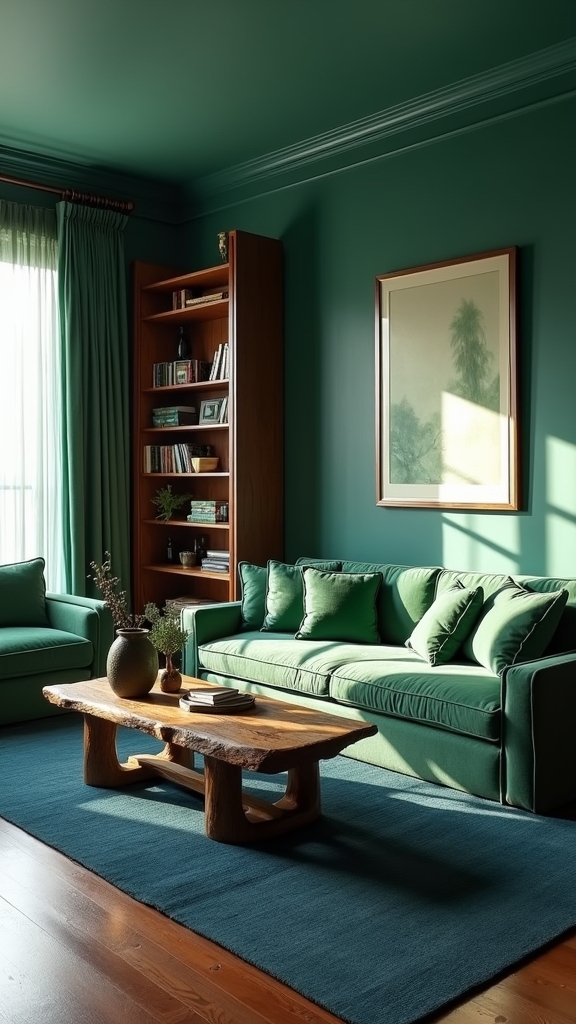
By thoughtfully combining wood tones with blue-green palettes, designers achieve a harmonious interplay between organic warmth and vibrant coolness.
Mixing wood tones with blue-green palettes enhances a living room’s depth and visual intrigue, while maintaining a natural, inviting atmosphere. The strategic use of wood—whether light or dark—can either complement or contrast blue-green hues, shaping the room’s mood and sophistication.
- Select wood tones intentionally: Light woods like birch and maple pair effortlessly with pastel blue-green shades for a fresh, airy ambiance.
- Incorporate grounding accents: Furniture or shelving in darker woods such as walnut or mahogany offers depth against saturated blue-green walls.
- Play with finishes: Stained wood that matches or contrasts the palette provides additional dimension, amplifying the space’s biophilic essence and modern appeal.
For a minimalist living room, consider neutral color palettes to create a calming ambiance that complements the blue-green tones.
Balancing With Ochre, Brown, or Brass
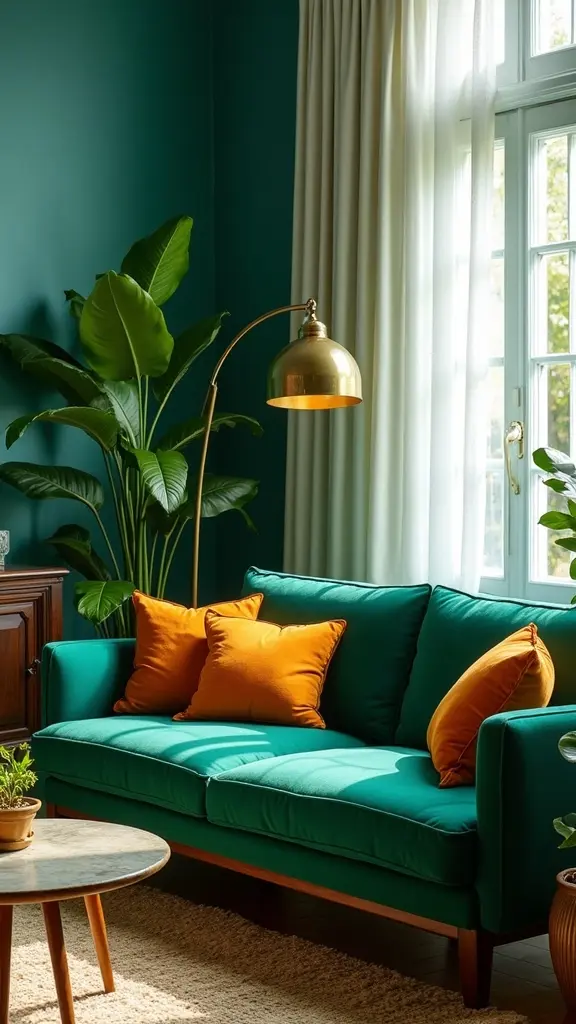
Balancing blue and green schemes with ochre, brown, or brass introduces essential warmth and grounding to the palette. Ochre and light brown accents evoke natural harmony, while brass fixtures or decor serve as refined focal points, enhancing both cohesion and visual intrigue. Strategic placement of these elements guarantees the space maintains a sophisticated equilibrium without overpowering the senses. Incorporating greenery decor, such as indoor plants that thrive, adds a calming atmosphere and purifies the air, complementing the overall design aesthetic.
Adding Warm Ochre Accents
When introduced thoughtfully, warm ochre accents act as a dynamic counterbalance to the cool undertones of blue and green, fostering a harmonious and inviting atmosphere within the living room.
Expertly applied, ochre punctuates the space with visual warmth, enhancing both mid-greens and deep blues without overshadowing their vibrancy.
For a cohesive and visually compelling composition, consider the following strategies:
- Textural Contrast: Integrate ochre cushions or throws to add tactile dimension, softening the sharpness of green undertones.
- Focal Points: Select an ochre-hued rug or artwork to anchor the room, unifying disparate blue and green elements with grounded earthiness.
- Layering Hues: Employ varying intensities of ochre across accessories to create depth, ensuring balance and maintaining a sophisticated, curated aesthetic.
Incorporating Brown and Brass
Building upon the inviting warmth introduced by ochre, the integration of brown and brass infuses a living room with tactile richness and refined contrast.
Brown tones—whether in leather seating, wooden furniture, or textured textiles—anchor the blue and green palette, evoking a sense of grounded sophistication reminiscent of natural environments.
Brass accents, such as sleek light fixtures, sculptural hardware, or decorative vases, lend a subtle yet striking elegance, catching the light and providing visual punctuation amid cooler hues.
For a cohesive approach, designers recommend layering brown through soft furnishings like cushions or throws, ensuring the color story remains harmonious rather than overpowering.
Selective brass detailing further enlivens the scheme, elevating the overall aesthetic with a touch of contemporary glamour and visual intrigue.
Bold Patterned Rugs and Cushions
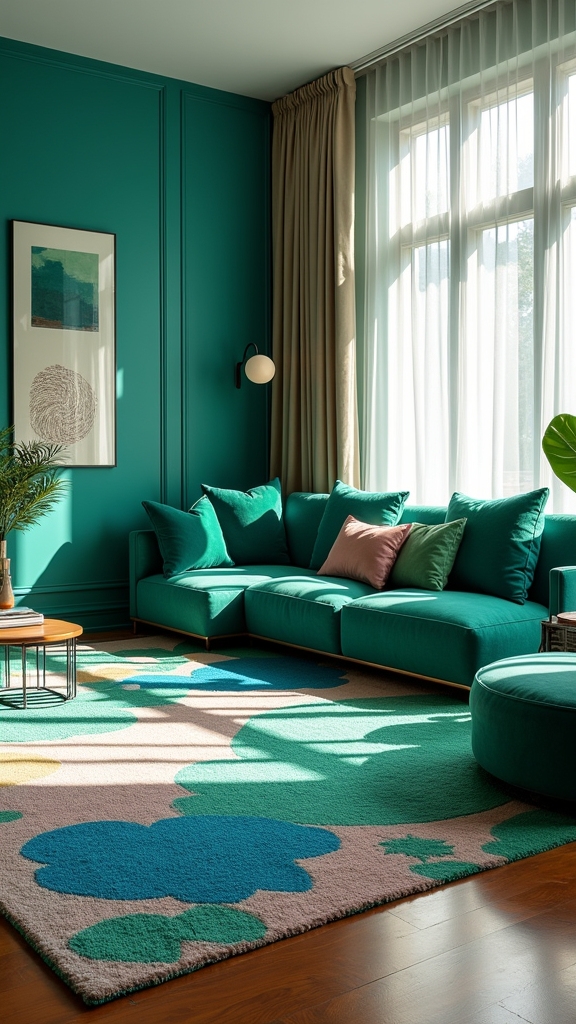
Although the foundation of a living room often lies in its palette, the introduction of bold patterned rugs and cushions transforms a green and blue space into a visually compelling environment. Expertly selected soft furnishings reinforce the interplay between bold colour and organic motifs, especially when paired with green botanical wallpaper. For maximum impact, consider the following:
- Focal Point: Opt for large-scale geometric or floral rugs that anchor the room, introducing movement and a vibrant focal point against calming greens and blues.
- Pattern Play: Layer cushions in complementary patterns—think stripes, botanicals, or abstract prints—to create visual rhythm and invite the eye to explore.
- Colour Cohesion: Select rugs and cushions that incorporate both green and blue, ensuring seamless visual shifts and a curated, cohesive aesthetic throughout the living space.
Incorporating textured wall panels can further enhance the ambiance, adding depth and interest that complements the vibrant patterns of your soft furnishings.
Layering Textures for Depth
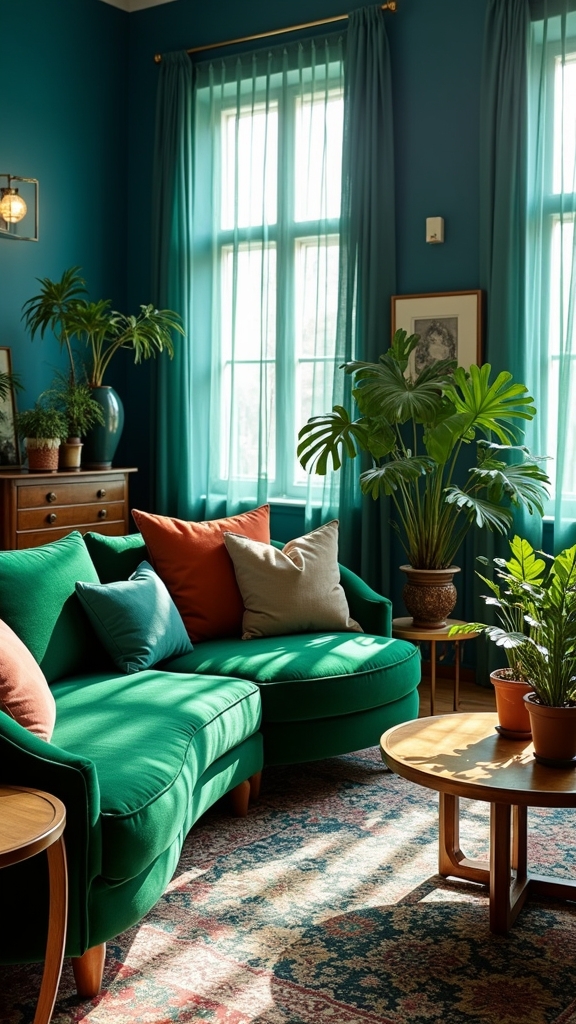
Beyond bold patterns, the interplay of layered textures introduces nuanced depth and tactile sophistication to a green and blue living room. Expertly combining plush velvet cushions, woven throws, and intricately patterned rugs, designers achieve a multidimensional effect where each element magnifies the harmony of green and blue hues. Layering textiles in varying shades offers both visual cohesion and a sense of warmth, while incorporating organic materials—such as natural wood and sleek metal accents—grounds the palette with an inviting, contemporary edge. Textured wall finishes, whether through paint or wallpaper, become striking backdrops that underscore the richness of layered furnishings. Pairing high-profile upholstered pieces with streamlined furniture maintains a balanced aesthetic, ensuring the space remains visually engaging without overwhelming the senses. Additionally, layering rugs for warmth involves choosing complementary colors to harmonize the layered rugs, mixing textures by pairing plush with natural fibers for a sophisticated look.
Light and Airy Spaces With Soft Greens
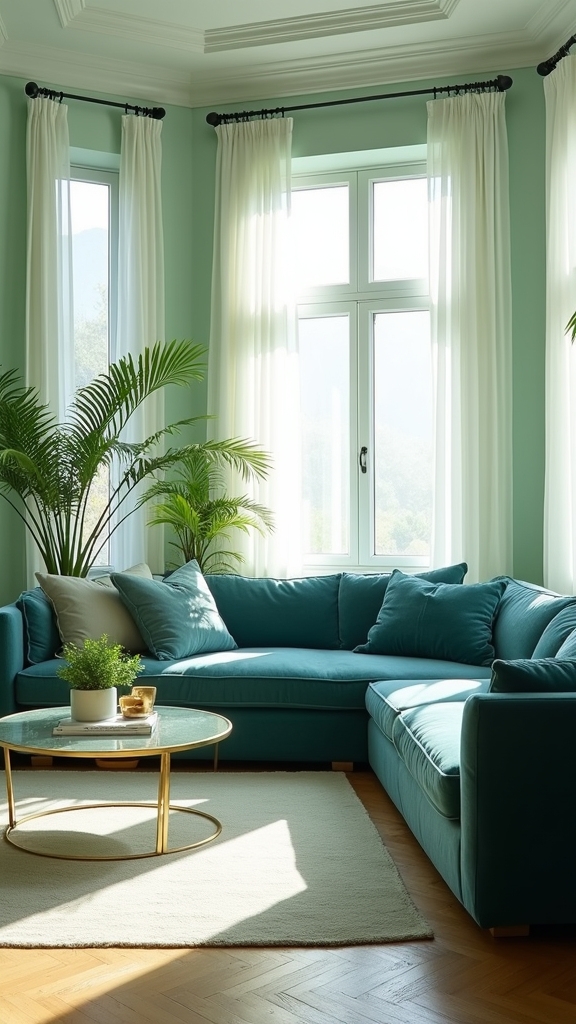
A palette anchored by soft greens, particularly pastel shades, introduces a fresh and tranquil ambiance to contemporary living rooms.
Designers often leverage light green walls to amplify natural daylight, making compact interiors feel more expansive and inviting. The interplay of soft greens with white or neutral elements establishes a refined, luminous backdrop that enhances spatial perception.
Light green walls paired with neutrals create a luminous, expansive atmosphere, transforming even compact living rooms into inviting, airy sanctuaries.
For ideal effect, consider these key strategies:
- Use light green walls to reflect and diffuse sunlight, fostering an airy, open feel.
- Incorporate lightweight textiles such as linen or cotton in upholstery and drapery, complementing the softness of the color palette.
- Layer white or beige accessories—think rugs, cushions, and minimalistic decor—to accentuate brightness and foster an elegant, serene living environment.
Statement Wallpaper in Blue or Green
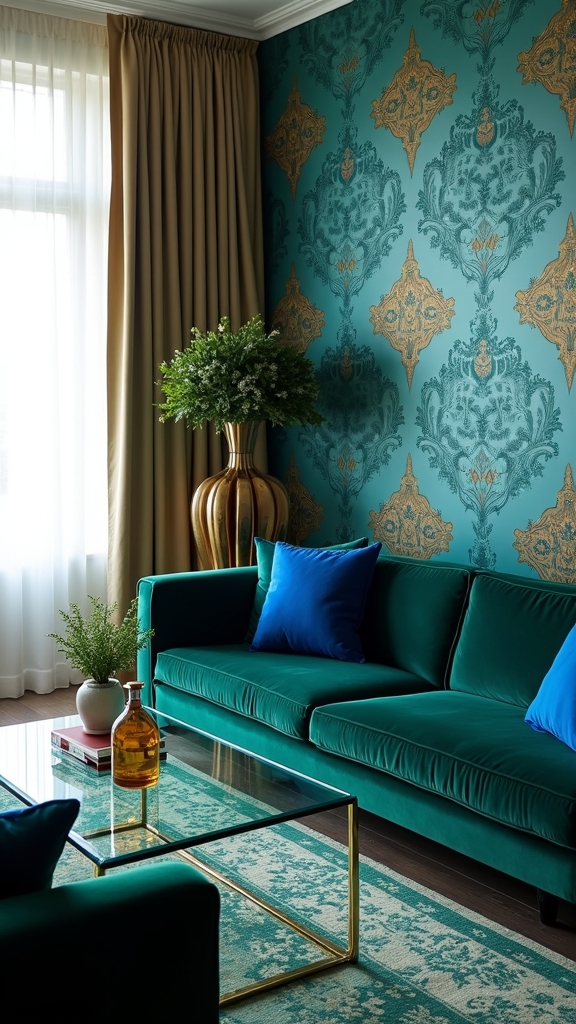
Opting for statement wallpaper in saturated blue or green tones introduces dynamic pattern and establishes a commanding focal point within the living room.
Selecting motifs such as tropical botanicals or structured geometrics enhances spatial depth and visual intrigue.
For a cohesive aesthetic, designers recommend echoing the wallpaper’s palette in key furniture pieces, ensuring visual continuity and balance.
Choosing Bold Pattern Designs
Many contemporary living rooms achieve visual impact through the application of statement wallpaper in bold blue or green hues, establishing an immediate focal point.
Selecting the right pattern design is vital for creating a balanced yet visually dynamic environment. Interior experts recommend utilizing large-scale florals or geometric motifs in these bold, green-centric palettes to introduce visual depth and textural interest.
The following expert strategies can guide pattern selection:
- Scale and Proportion: Opt for oversized patterns to maximize drama, especially in spacious rooms.
- Lighting Considerations: Deep blue or green wallpapers foster intimacy, while lighter variations promote openness and luminosity.
- Pattern Mixing: Combine statement wallpapers with subtle, coordinated patterns—such as green stripes or blue geometrics—to achieve layered sophistication.
Removable wallpaper options further allow effortless experimentation with bold, green patterns.
Coordinating Wallpaper With Furniture
When introducing statement wallpaper in bold blue or green, visual cohesion depends on thoughtfully aligning the wallpaper’s palette and pattern with the living room’s furniture selection. Achieving balance involves considering the dominant Colour Scheme and ensuring the wallpaper’s tones either contrast elegantly or complement the upholstery. Integrating wall panelling in a coordinating hue can further unify the scheme. Pattern scale should relate to furniture dimensions—oversized motifs pair best with substantial sofas, while finer prints suit smaller accent chairs. Texture also plays an essential role; a matte leafy wallpaper echoes velvet upholstery, while metallic finishes pair well with glossy surfaces. Accessories, such as cushions or throws, should echo wallpaper tones for harmonious layering.
| Wallpaper Idea | Coordinating Furniture |
|---|---|
| Emerald geometric | Navy velvet sofa |
| Leafy green matte | Green velvet armchair |
| Blue metallic stripes | Glossy lacquered credenza |
| Teal damask | Deep blue wall panelling |
| Aqua floral | Patterned cushions, neutral sofa |
Retro-Inspired Green and Blue Schemes
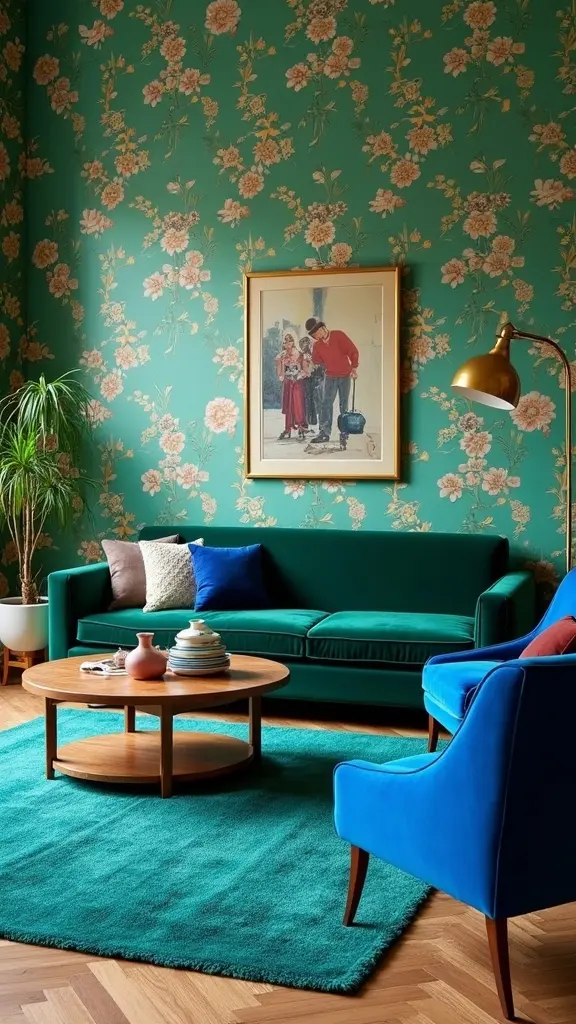
While retro-inspired green and blue schemes draw from the bold palettes of the 1970s, their effectiveness lies in the deliberate interplay of color and form.
Designers recommend integrating forest green with vibrant blues, offset by warm pinks or terracotta, for a transformative living room makeover. Visual interest is heightened through patterned textiles and geometric prints that reinforce the period’s aesthetic and provide structure to the color story.
Curved, vintage-style furniture and strategic use of brass or wooden accents further anchor the scheme, imparting sophistication and warmth. For a striking effect, consider these expert tips:
- Use floor-to-ceiling curtains in saturated green or blue for dramatic framing.
- Select large-scale geometric rugs or upholstery for visual cohesion.
- Incorporate sculptural vintage furniture to echo retro charm.
Gallery Walls in Complementary Hues
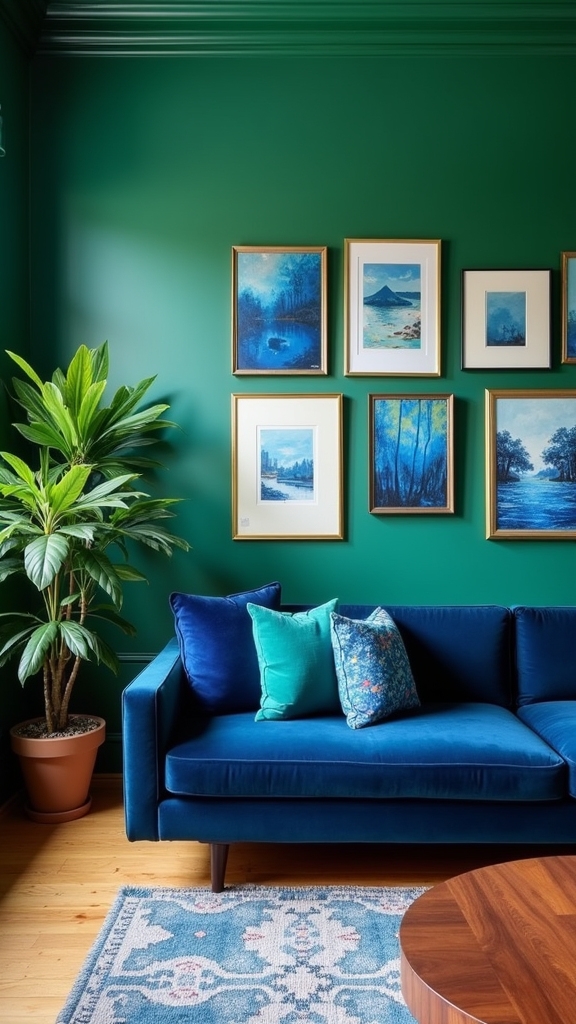
Although living room gallery walls often serve as decorative anchors, their impact is magnified by the strategic use of complementary hues such as green and blue.
Expert designers recommend thoughtfully curating artwork that features a spectrum of these colors—think soft blue watercolors juxtaposed with deep green botanical prints.
A gallery wall achieves visual cohesion when these complementary hues are unified within a consistent palette, yet interest is maintained by mixing frame styles and sizes. Incorporating both matte and glossy finishes further heightens textural depth.
For ideal effect, a neutral background allows the vibrant blues and greens to take center stage without overwhelming the space. This approach results in a bold yet balanced focal point, seamlessly integrating the gallery wall into the living room’s overall design scheme.
To enhance the room’s ambiance, consider utilizing layered lighting options to highlight the gallery wall, which will create depth and mood within the space.
Incorporating Plants for Natural Harmony
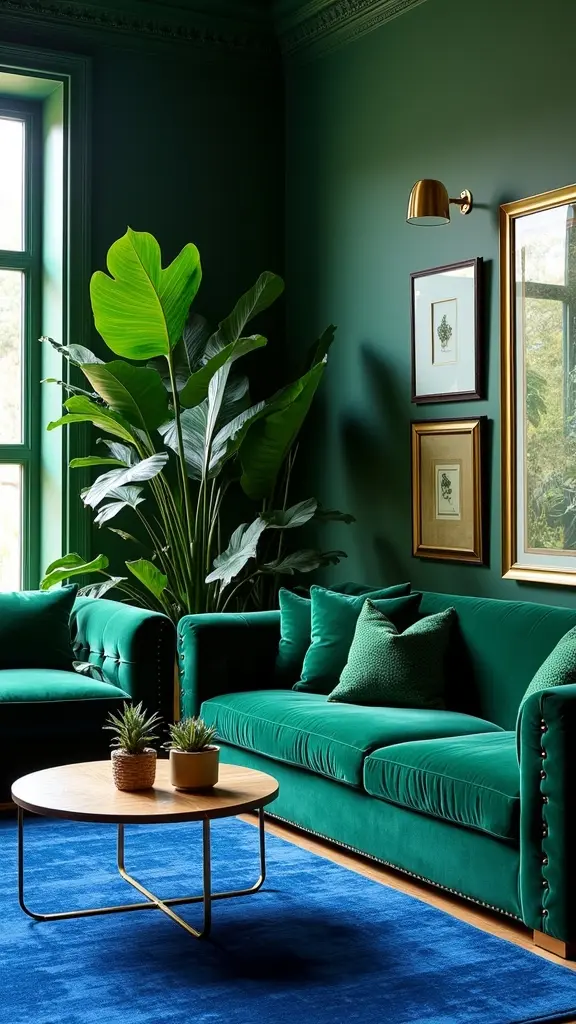
Integrating indoor plants into a living room design infuses the space with organic texture and visual vibrancy, reinforcing the green elements within a blue and green palette.
Plants contribute not only to aesthetic cohesion but also to air purification, creating a healthier environment.
For ideal visual impact and style balance, consider the following techniques:
- Vary plant scale and species: Combine large statement plants like fiddle leaf figs with smaller varieties such as pothos to generate layered depth and dimension.
- Utilize decorative planters: Select pots in blue, green, or patterned motifs that echo the room’s color scheme, ensuring seamless integration.
- Strategic placement: Position plants to highlight focal points, frame furniture groupings, or soften architectural lines, enhancing the room’s natural harmony and color interplay.
Modern Scandi Touches With Blue and Green
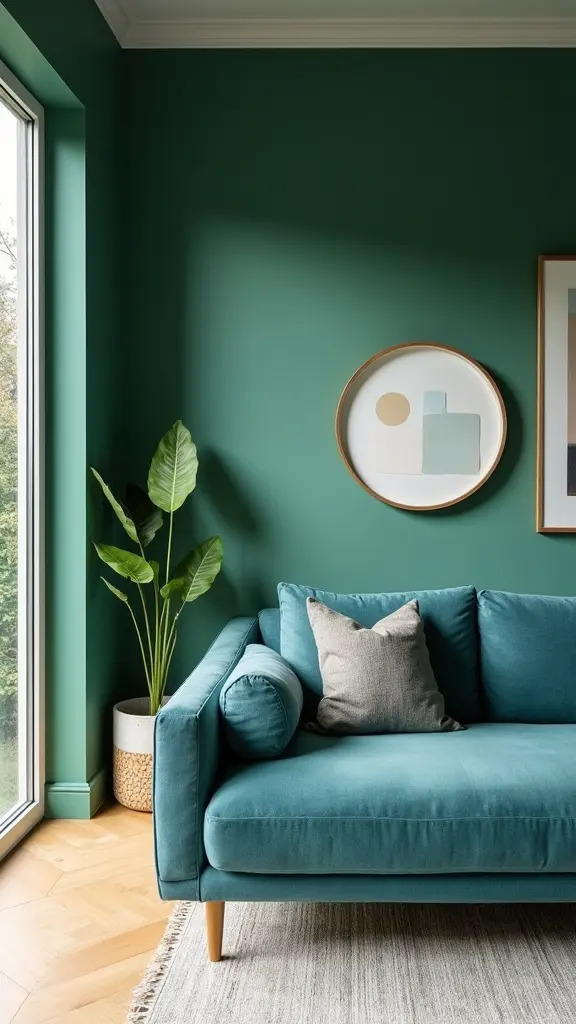
A harmonious blend of modern Scandi style and a blue-green palette creates a living room that is both visually tranquil and functionally refined.
Modern Scandi decor’s foundation of clean lines and minimalism is enhanced by the use of blue and green hues, which introduce serenity and subtle dynamism.
Blue and green hues elevate modern Scandi minimalism, infusing spaces with both calming serenity and a gentle sense of movement.
Opting for lightweight furniture in pale blue or muted green enhances the room’s open, airy character.
Natural materials—light woods, soft linen, and textured knits—reinforce the connection to nature, a hallmark of Scandinavian design.
To introduce organic vibrancy, oversized plants and botanical prints in layered green shades are recommended.
For tactile interest, layering textiles such as knitted throws and pastel cushions in blue and green tones achieves a cozy yet contemporary ambiance with unmistakable Scandi sophistication.
Frequently Asked Questions
Can You Mix Blue and Green in the Living Room?
Combining blue and green in a living room leverages color psychology to evoke tranquility and freshness. Expert design balance is achieved by layering contrasting hues, integrating tactile materials, and grounding with neutrals for a visually cohesive, sophisticated scheme.
What Colors Look Good With Green and Blue?
When selecting color combinations with green and blue, designers often recommend introducing accent hues such as bright yellow, coral, warm oranges, or soft pinks. These strategic additions enhance visual interest and foster a dynamic, cohesive palette in interior spaces.
Do Blues and Greens Go Together?
Blues and greens are frequently paired due to their analogous relationship on the color wheel and shared nature inspiration. Color psychology highlights their calming synergy, while expert style guidance recommends combining varied tones for visual harmony and depth.
What Color Harmony Is Blue and Green?
Blue and green exemplify an analogous color harmony, favored in design trends for its seamless shift and visual continuity. Color psychology underscores their calming effects, while expert style guidance suggests layering tones to enhance spatial depth and sophistication.
Conclusion
A green and blue living room offers endless scope for sophisticated, expressive design. Through strategic layering—contrasting smoky greens with vibrant blues, integrating tactile materials like velvet, and balancing botanical motifs—the palette achieves both energy and serenity. Whether curated with retro elements, gallery walls, or modern Scandi touches, this color duo guarantees a visually engaging, harmonious space. Thoughtful selection of shades and textures guarantees the room remains cohesive, inviting, and undeniably stylish for years to come.
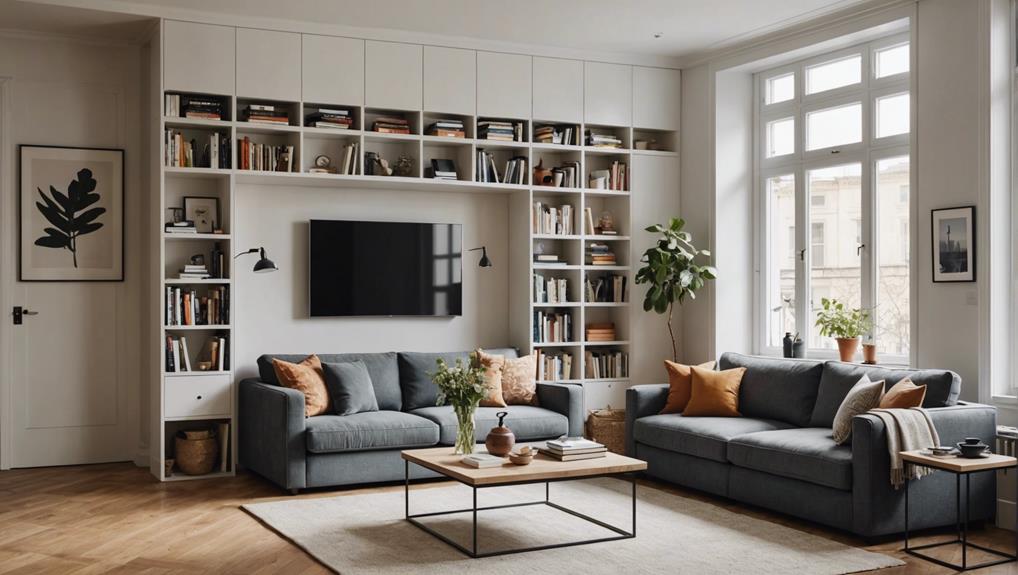
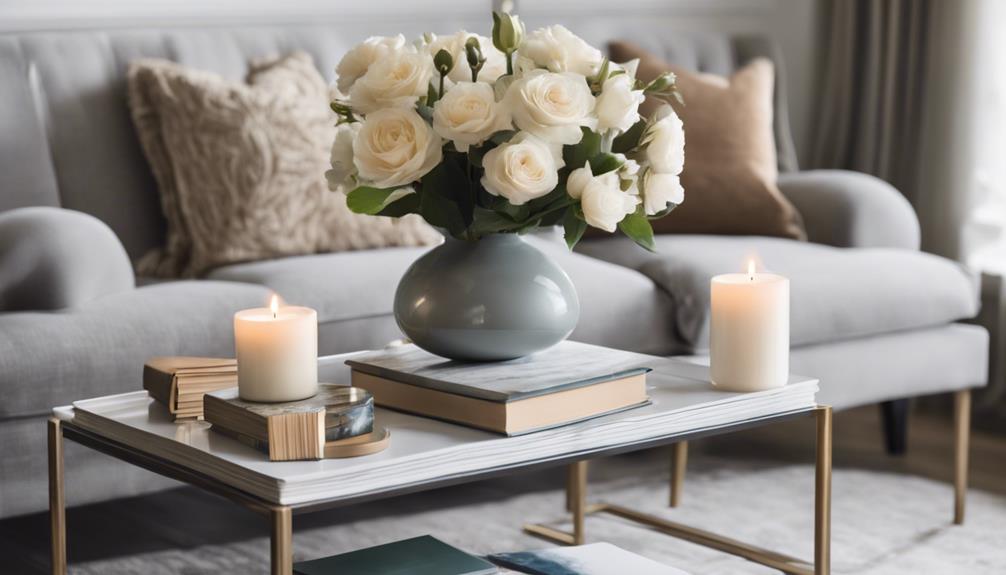
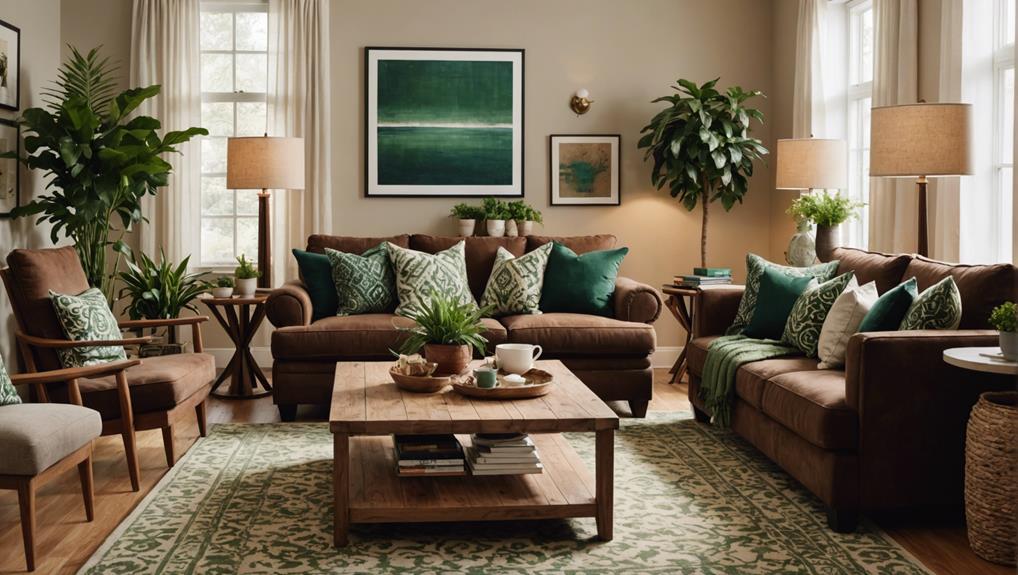
Leave a Reply